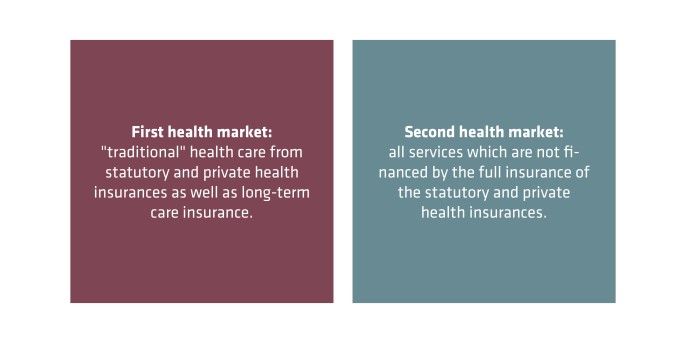14. December 2020 By Dr. Thorsten Hagemann
Digital Health Applications – and their alternative market access routes
The introduction of the Digital Health Care Act (Digitales-Versorgungs-Gesetz, DVG) and the Digital Health Applications Ordinance (Digitale-Gesundheitsanwendungen-Verordnung, DIGAV) in 2020 created a basis for digital health applications (DiGA) in the medical care process. Thanks to the German Federal Institute for Drugs and Medical Devices (Bundesinstitut für Arzneimittel und Medizinprodukte, BfArM) approving the DiGA as a medical device through its fast-track process, it can be positioned in statutory health insurance providers’ standard care offerings and made accessible to millions of policyholders as an ‘app on prescription’. adesso also identifies, opens up and facilitates alternative business models in addition to the usual process support it provides. In my blog post, I will show you what alternatives there are for the primary health market.
Alternative business models in the primary health care market
The health market is more heavily regulated than most any other target market. Both medicine and industry are extremely interested in the possibility of facilitating market access and thus further promoting competition and digitalisation.
We do not see alternative market access as a substitute for statutory access regulations. On the contrary. The medical apps that cannot obtain approval to be a medical device, as is necessary for a DiGA, should focus on alternatives. In this blog post, I would like to show you what alternatives we can open up for you.

1. Directory of medical aids
To be included in the list of medical aids, manufacturers must prove that they function properly, are safe, meet quality requirements and – where necessary – the medical benefit. These conditions are deemed to be met when the aid has been approved as a medical device and has a CE marking. However, Section 33 of the German Social Code, Book V, (Sozialgesetzbuch, SGB V) states: ‘Insured persons are entitled to be provided with hearing aids, body prostheses, orthopaedic and other aids that are necessary in individual cases to ensure the success of medical treatment to prevent a threatened disability or to compensate for a disability [...]’.
Can a piece of software in the sense of a medical app also function as an aid like in the description above? This is where our approach is born: there are no existing regulations on software or apps used as aids. However, there must be a specific reference to a care situation, illness or therapy. The German National Association of Health Insurance Funds (Spitzenverband Bund der Krankenkassen) decides whether something is included in the list of medical aids.
2. Further development of care
According to Sections 63, 64 of the German Social Code, Book V, (Sozialgesetzbuch, SGB V), health insurance providers can agree to improve the quality and efficiency of their care models to further develop the procedural, organisational, financing and remuneration forms of the service they provide. First and foremost, this addresses models that were not previously anchored in standard care offerings. These funding opportunities are subject to an obligation to provide evidence of medical benefit to the regulatory authorities of the statutory health insurance providers. They must demonstrate cost-effectiveness through savings that offset any additional expenditure. This makes it possible for medical apps with and without CE approval to be financed by health insurance providers.
3. Prevention apps
Statutory health insurance providers also offer their members health education sessions and further health information. These are apps that provide information about or on specific health topics. This also includes apps that optimise and/or simplify communication and administration. The customer loyalty and acquisition measures, which are mostly represented by framework apps, also fit into these informative applications.
The focus here is on behavioural prevention (according to Section 20 SGB V), which is promoted or also financed by the statutory health insurance providers. These are mostly evaluated courses that follow the ‘Prevention Guidelines’ (‘Leitfaden Prävention’) set out by the National Association of Statutory Health Insurance Funds (Spitzenverband Bund der Krankenkassen) and involve trained, personal advisors. These options for being reimbursed by SHIs require individual negotiations with the respective health insurance providers in which we play a supporting role.
4. Selective agreements
‘140a agreements’ deal with different types of care scenarios. According to the corresponding paragraph of the German Social Code, Book V, apps and app-based forms of care are eligible for funding. These must generate a cross-sector or interdisciplinary benefit along medical processes. If the agreements are concluded directly between the health insurance provider and the app manufacturer, special requirements apply in terms of the new Medical Device Regulation (Regulation (EU) 2017/745 on medical devices).
5. Rehabilitation
Measures that directly follow hospital stays, rehabilitation, aftercare or training measures can also be covered by health insurance providers according to Section 43 SGB V. This also applies to relatives or caregivers.
The medical benefit as well as the economic viability must be proven in this case, too. It is usually easier to access these individual reimbursement options than it is to access standard care.
6. Medical apps in the inpatient sector
Hospital and clinic services are generally invoiced using the diagnosed-related groups (DRG) system. This means that hospitals and clinics are free to choose and pay for an app.
The agreements and prices are negotiated individually between manufacturers and service providers. Whether an app has to be a medical device depends on the care process in question and the medical benefit it generates. If hospitals or clinics establish a new examination or treatment method in this context, these new procedures can be positioned in the app for the Institute for Hospital Charges (Institut für Entgeltwesen im Krankenhaus, InEK for short) as a request for a new charge. If the decision is positive, negotiations can then be held with the health insurance providers about reimbursement of costs.
7. Standard care provided by statutory health insurance providers
In principle, standard care is a collective agreement between the National Association of Statutory Health Insurance Physicians (Kassenärztliche Bundesvereinigung) and the National Association of Health Insurance Funds. The agreements apply to outpatient and office-based care and can be provided and billed by all suitable GPs and panel doctors.
The remuneration is regulated in the uniform assessment scale (Einheitlicher Bewertungsmaßstab, EBM): medical apps can be included in the fee for office-based doctors (using the EBM) or reimbursed separately. The interesting thing here is that medical expenses in kind are also eligible for reimbursement. Plus, individual agreements can be made between the health insurance providers and panel doctors’ associations at the state level if they cannot be paid using the EBM.
Conclusion
Not all medical apps automatically become a DiGA and participate in the central market access scheme. It is extremely important to pinpoint, identify and facilitate alternative market access routes. This will also make it possible for apps without approval as medical devices to remain competitive and to be part of the digitalisation process in the healthcare sector. In addition to the traditional fast-track procedure for DiGAs, our experts also provide options for alternative routes. In all we do we follow the philosophy of ‘everything from a single source’.
If you would like to find out more about how we can provide you with support from the initial idea to the finished DiGA, then take a look at our website.

